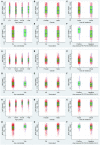Seroprevalence of SARS-CoV-2-specific anti-spike IgM, IgG, and anti-nucleocapsid IgG antibodies during the second wave of the pandemic: A population-based cross-sectional survey across Kashmir, India
- PMID: 36276377
- PMCID: PMC9582950
- DOI: 10.3389/fpubh.2022.967447
Seroprevalence of SARS-CoV-2-specific anti-spike IgM, IgG, and anti-nucleocapsid IgG antibodies during the second wave of the pandemic: A population-based cross-sectional survey across Kashmir, India
Abstract
Background: Within Kashmir, which is one of the topographically distinct areas in the Himalayan belt of India, a total of 2,236 cumulative deaths occurred by the end of the second wave. We aimed to conduct this population-based study in the age group of 7 years and above to estimate the seropositivity and its attributes in Kashmir valley.
Methods: We conducted a community-based household-level cross-sectional study, with a multistage, population-stratified, probability-proportionate-to-size, cluster sampling method to select 400 participants from each of the 10 districts of Kashmir. We also selected a quota of healthcare workers, police personnel, and antenatal women from each of the districts. Households were selected from each cluster and all family members with age 7 years or more were invited to participate. Information was collected through a standardized questionnaire and entered into Epicollect 5 software. Trained healthcare personnel were assigned for collecting venous blood samples from each of the participants which were transferred and processed for immunological testing. Testing was done for the presence of SARS-CoV-2-specific anti-spike IgM, IgG antibodies, and anti-nucleocapsid IgG antibodies. Weighted seropositivity was estimated along with the adjustment done for the sensitivity and specificity of the test used.
Findings: The data were collected from a total of 4,229 participants from the general population within the 10 districts of Kashmir. Our results showed that 84.84% (95% CI 84.51-85.18%) of the participants were seropositive in the weighted imputed data among the general population. In multiple logistic regression, the variables significantly affecting the seroprevalence were the age group 45-59 years (odds ratio of 0.73; 95% CI 0.67-0.78), self-reported history of comorbidity (odds ratio of 1.47; 95% CI 1.33-1.61), and positive vaccination history (odds ratio of 0.85; 95% CI 0.79-0.90) for anti-nucleocapsid IgG antibodies. The entire assessed variables showed a significant role during multiple logistic regression analysis for affecting IgM anti-spike antibodies with an odds ratio of 1.45 (95% CI 1.32-1.57) for age more than 60 years, 1.21 (95% CI 1.15-1.27) for the female gender, 0.87 (95% CI 0.82-0.92) for urban residents, 0.86 (95% CI 0.76-0.92) for self-reported comorbidity, and an odds ratio of 1.16 (95% CI 1.08-1.24) for a positive history of vaccination. The estimated infection fatality ratio was 0.033% (95% CI: 0.034-0.032%) between 22 May and 31 July 2021 against the seropositivity for IgM antibodies.
Interpretation: During the second wave of the SARS-CoV-2 pandemic, 84.84% (95% CI 84.51-85.18%) of participants from this population-based cross-sectional sample were seropositive against SARS-CoV-2. Despite a comparatively lower number of cases reported and lower vaccination coverage in the region, our study found such high seropositivity across all age groups, which indicates the higher number of subclinical and less severe unnoticed caseload in the community.
Keywords: COVID-19; SARS-CoV-2; antibodies; epidemiology; seroprevalence.
Copyright © 2022 Lone, Khan, Qurieshi, Majid, Pandit, Haq, Ahmad, Bhat, Bashir, Bilquees, Fazili, Hassan, Jan, Kaul, Khan, Mushtaq, Nazir, Qureshi, Raja, Rasool, Asma, Bhat, Chowdri, Ismail, Jeelani, Kawoosa, Khan, Khan, Kousar, Lone, Nabi, Qazi, Rather, Sabah and Sumji.
Conflict of interest statement
The authors declare that the research was conducted in the absence of any commercial or financial relationships that could be construed as a potential conflict of interest.
Figures





References
-
- MoHFW | Home [Internet] . Mohfw.gov.in. (2021). [cited 1 November 2021]. Available online at: https://mohfw.gov.in/
-
- Timeline: WHO's COVID-19 response [Internet] . Who.int. (2022). Available from: https://www.who.int/emergencies/diseases/novel-coronavirus-2019/interact... (accessed January 11, 2022).
-
- WHO Coronavirus (COVID-19) Dashboard [Internet]. Covid19.who.int. (2021). Available online at: https://covid19.who.int/ (accessed October 1, 2021).
-
- Coronavirus in India: Latest Map and Case Count [Internet] . Covid19india.org. (2022). Available online at: https://www.covid19india.org/ (accessed January 12, 2022).
-
- Khan S, Qurieshi M, Haq I, Majid S, Ahmad J, Ayub T, et al. . Seroprevalence of SARS-CoV-2-specific IgG antibodies in Kashmir, India, 7 months after the first reported local COVID-19 case: results of a population-based seroprevalence survey from October to November (2020). BMJ Open. (2021) 11:e053791. 10.1136/bmjopen-2021-053791 - DOI - PMC - PubMed
Publication types
MeSH terms
Substances
LinkOut - more resources
Full Text Sources
Medical
Miscellaneous

